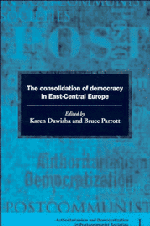Book contents
- Frontmatter
- Contents
- List of tables
- List of contributors
- Preface
- 1 Perspectives on postcommunist democratization
- 2 Democratization and political participation: research concepts and methodologies
- 3 Democratic consolidation in Poland after 1989
- 4 Party politics and political participation in postcommunist Hungary
- 5 Democratization and political participation: the experience of the Czech Republic
- 6 Democratization and political participation in Slovakia
- 7 Democratization and political participation in postcommunist societies: the case of Latvia
- 8 Democratization in Lithuania
- 9 Democratization and political development in Estonia, 1987–96
- Appendix
- Index
3 - Democratic consolidation in Poland after 1989
Published online by Cambridge University Press: 01 June 2011
- Frontmatter
- Contents
- List of tables
- List of contributors
- Preface
- 1 Perspectives on postcommunist democratization
- 2 Democratization and political participation: research concepts and methodologies
- 3 Democratic consolidation in Poland after 1989
- 4 Party politics and political participation in postcommunist Hungary
- 5 Democratization and political participation: the experience of the Czech Republic
- 6 Democratization and political participation in Slovakia
- 7 Democratization and political participation in postcommunist societies: the case of Latvia
- 8 Democratization in Lithuania
- 9 Democratization and political development in Estonia, 1987–96
- Appendix
- Index
Summary
Our democracy is like a reed – it sways in the wind and a strong gust can hurt it. It was almost never used before, and that is why we lack experience on how to use it now.
Dariusz Fikus, “Demokracja jak trzcina,” Rzeczpospolita, May 22, 1995.Overview
The Republic of Poland, or the “Third Republic” as the Poles refer to it to emphasize continuity with the interwar “Second Republic,” is a medium-size country with a population of 38.5 million and an estimated per capita GDP of about US$5,000. Located between Germany and the former Soviet Union, Poland is a pivotal state for the future stability and security in postcommunist Central Europe. After six years of radical political and economic reform, by 1996 Poland has established an institutional framework for democracy and a free market economy. The country has developed a parliamentary-presidential system of government, codified in the 1992 “Little Constitution.” In 1990 Poland opened its economic system to market competition by introducing a radical reform package, the so-called “Balcerowicz program” named after the country's finance minister in the first Solidarity government; two years later the country began to see the benefits of the economic “shock therapy.” The economic basket case of Eastern Europe in the 1980s, after 1992 Poland began to recover, posting 5.0 and 5.5 percent GDP growth rates in 1994 and 1995, respectively, and reducing the inflation rate to under 30 percent by 1995.
- Type
- Chapter
- Information
- The Consolidation of Democracy in East-Central Europe , pp. 65 - 108Publisher: Cambridge University PressPrint publication year: 1997
- 6
- Cited by



